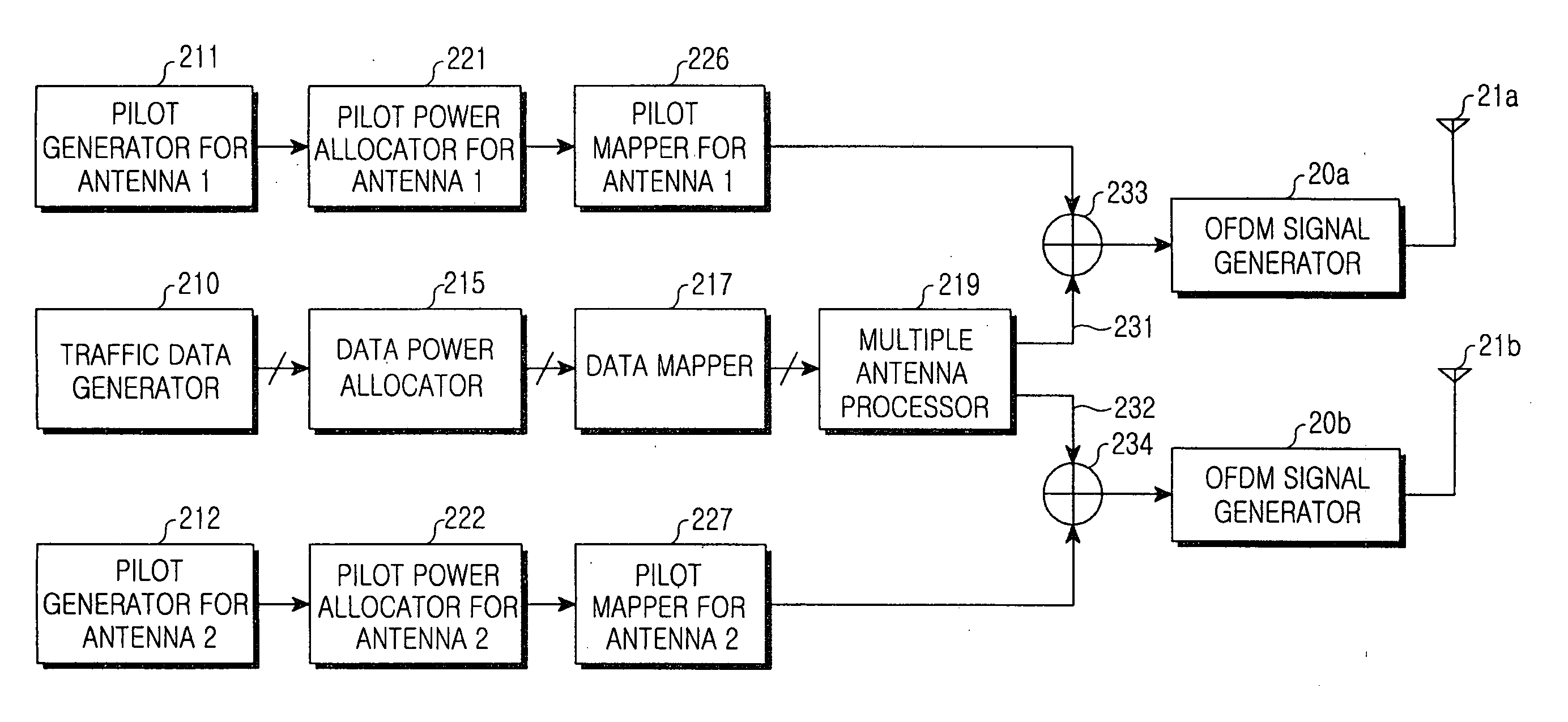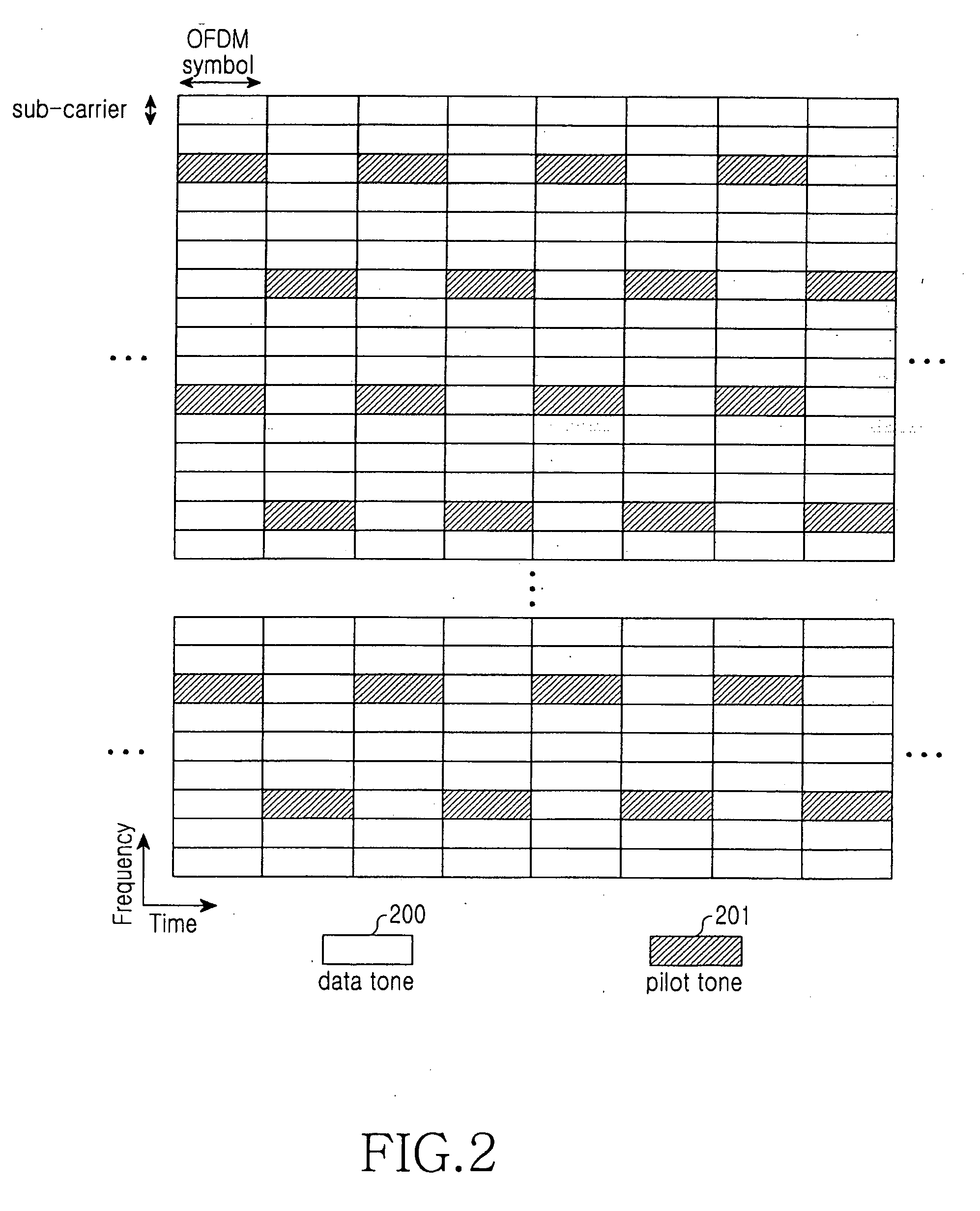Apparatus and method for transmitting and receiving pilot signal using multiple antennas in a mobile communication system
a mobile communication system and antenna technology, applied in multi-frequency code systems, multiplex communication, orthogonal multiplex, etc., can solve the problems of inefficient allocation of time-frequency resources to pilot signals, high-speed wireless communication, and limited application of dm to real systems. to achieve the effect of preventing errors in interference estimation
- Summary
- Abstract
- Description
- Claims
- Application Information
AI Technical Summary
Benefits of technology
Problems solved by technology
Method used
Image
Examples
first embodiment
[0072]FIG. 6 illustrates an exemplary pilot allocation method for two transmit antennas according to the present invention.
[0073] Referring to FIG. 6, the horizontal axis represents time and the vertical axis represents frequency. Reference numerals 301 and 302 denote pilot signals from antenna 1 and antenna 2, respectively. One pilot is defined by two OFDM symbols in time and continues along a predetermined frequency axis. That is, a pilot signal is sent on a predetermined subcarrier across all OFDM symbols. Pilot signals from different transmit antennas use the same subcarrier. Since orthogonality is not ensured between different pilot signals on the same time-frequency bin, the pilot signals are Walsh-covered on the basis of two successive OFDM symbols. Hence, a receiver must Walsh-decover every two successive OFDM symbols for channel estimation. In the illustrated case of FIG. 6, W2[1,:] denotes a first Walsh code (+1, +1) of length 2, and W2[2,:] denotes a second Walsh code (+1...
fourth embodiment
[0105]FIG. 17 illustrates an exemplary pilot allocation method using a binary Walsh code for four transmit antennas according to the present invention.
[0106] Referring to FIG. 17, if, for example, twice as many time-frequency bins as those used for supporting two transmit antennas are available in supporting four transmit antennas, pilots can be allocated in the manner illustrated in FIG. 17. Walsh covering using Walsh codes of length 2 is performed to ensure orthogonality between pilots 701 and 702 for antenna 1 and antenna 2 and between pilots 703 and 704 for antenna 3 and antenna 4, and the pilots 701 and 702 are allocated to different subcarriers as those for the pilots 703 and 704. This pilot allocation method has the same advantages and disadvantages as those of the pilot allocation illustrated in FIG. 15 except that the pilot allocation of FIG. 17 ensures robust orthogonality between pilots for different transmit antennas, relative to the pilot allocation of FIG. 15. While th...
fifth embodiment
[0108]FIG. 18 illustrates an exemplary pilot allocation method using a fixed pilot allocation and a distributed pilot allocation in combination according to the present invention.
[0109] Referring to FIG. 18, reference numerals 801 and 802 denote Walsh-covered pilot signals for antenna 1 and antenna 2, respectively. The pilot signals 801 and 802 are allocated to the same subcarriers in every OFDM symbol, one subcarrier per AMC subband. An AMC subband is a minimum frequency resource unit to which scheduling and AMC are applied. The receiver measures an SINR for each subband and reports the SINR measurements to the transmitter. Since the receiver estimates interference on an AMC subband basis, one subcarrier is allocated to a pilot signal in each AMC subband, for interference estimation. In this case, if the size of the AMC subband is too large, channel estimation for demodulation may be impossible because it is difficult to perform interpolation for estimation of a channel located bet...
PUM
 Login to View More
Login to View More Abstract
Description
Claims
Application Information
 Login to View More
Login to View More - R&D
- Intellectual Property
- Life Sciences
- Materials
- Tech Scout
- Unparalleled Data Quality
- Higher Quality Content
- 60% Fewer Hallucinations
Browse by: Latest US Patents, China's latest patents, Technical Efficacy Thesaurus, Application Domain, Technology Topic, Popular Technical Reports.
© 2025 PatSnap. All rights reserved.Legal|Privacy policy|Modern Slavery Act Transparency Statement|Sitemap|About US| Contact US: help@patsnap.com



